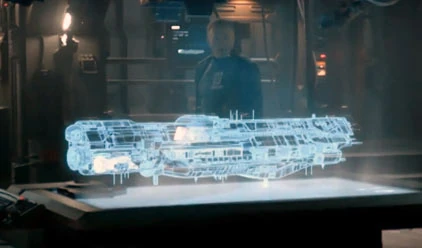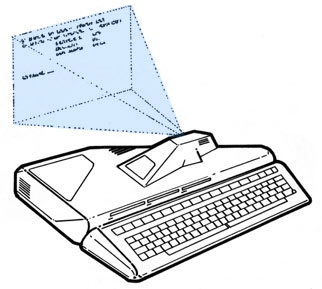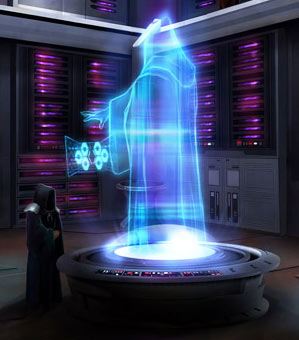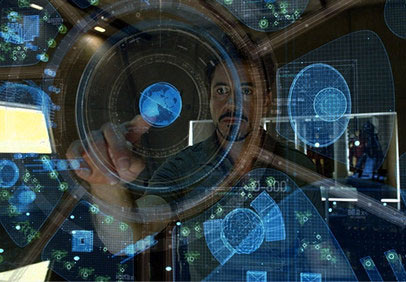
A holoprojector displaying starship schematics. For a blue starship, apparently.
A Holoprojector (often abbreviated to holoproj, and also known as a holotank, 3D, Tri-D, or Tri-Vid) creates three-dimensional moving holograms. It's the standard way to display media in the TI Universe, and holoprojectors are as common in the future as televisions screens and computer monitors are today. However, some devices, particularly datapads, continue to use flat-panel displays with privacy screen filters for customers (particularly K'Nes) who'd rather not display their secret proprietary information in the form of glowing holograms everyone in the room can see. A holoprojector produces an autostereoscopic display, meaning it emits an organized arrangement of light to create not just one image, but rather 360 different images that can be seen from 360 different angles. Consequently, a person's left and right eyes see two slightly different images, but because of the parallax effect the brain combines them together and interprets it as a single image with volume and depth.
Holodisplays[]

Holodisplays: Bringing new meaning to the Blue Screen of Death.
Holoprojectors can display either pre-recorded three-dimensional images or live holocast transmissions (and play the accompanying audio). Specialized holoprojectors can also be used for playing interactive hologames.
Smaller, cheaper, low-quality holoprojectors can only create semi-transparent monochrome holograms with an upper limit on size. Larger, more expensive, high-quality units, however, can generate life-sized, solid-looking holograms in full color. Projecting a larger-than-life image for public display (as Vin Dane did when addressing his subjects right before the Battle of the Round Table) requires a HUGE holoprojector.
Holophones[]

With a holophone call, it's almost like the other person is there... and blue.
A standard holoprojector can also be used for communication, able to receive and display private holographic messages (usually encrypted for security ) live in real time. In order to send live 3D hologram transmissions for two-way communication, however, one needs a holophone, which requires a not just a specialized holoprojector, but also a holostudio system for recording your image. Holostudio equipment is large, complex, and usually not portable.
A Holocamera is actually multiple video cameras placed in a circle, all filming the object in the center from different angles. At least eight cameras are required, placed at 45° of separation, but expensive high-end models (used in movie and game studios, etc.) have as many as 360 cameras placed at 1° of separation. Media companies have specially designed high-end holostudios, of course, but when used for personal communication between average citizens, the cameras are usually discretely built into the walls of the room, office, bridge, cockpit, etc, and the person just needs to be sure they're standing in the center. For simplicity and convenience, furniture (desks, chairs, sofas, etc.) are usually placed in the exact center of the cameras, so the person always knows where to sit or stand. The video data from all angles are then combined together into a single volumetric image and transmitted to the receiving holophone.
Someone without a holostudio can still send audio and video to a receiving holoprojector using the built-in microphone and video camera on thier computer, datapad, etc., but their image will appear on the other holophone as a flat 2D image.
Holo-interfaces[]

Holo-interfaces are useful, practical, efficient... and blue.
Combining holoprojectors with motion sensors and gesture controls allows for holographic interfaces to be generated for computers or other equipment. By allowing displays and interfaces to essentially disappear when not being used, personal computers can be made extremely small and portable, sometimes as small as a wristwatch or even a ring. Again, the size of the holo-interface depends on the size of the holoprojector built into the device, and a holoproj tiny enough to be built into a ring-sized computer would only be able to generate an interface of a few square inches at best.
Behind the Scenes[]
Holoprojectors (or something similar) have been a staple of science fiction for decades. Traditionally, the holograms are blue and semi-transparent, mainly because that's how they were first portrayed on the big screen in Star Wars. There's no real reason for this, however, especially since we already have holoprojection technology TODAY that can display solid-appearing images in full color. To explain this inconsistency in the TI universe, we came up with the retconned explanation that cheap, low-quality holoprojectors only display semi-transparent monochrome images because they're cheaper to produce and thus more affordable for the average person. Lots of flat-panel 2D displays have also frequently appeared in the TI story cannon, so we again came up with the retcon explanation that this was for privacy concerns, took up less space, and were simply cheaper.